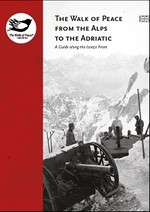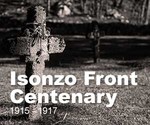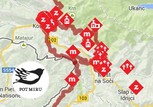97th Infantry Regiment
97th Infantry Regiment »Baron von Waldstätten« (K. u. K. Infanterieregiment Freiherr von Waldstätten Nr.97) was established on 1st January, 1883, from parts of infantry regiments 17th, 22nd and 79th and the 33rd Light Regiment. Until 1892, its honorary patron, who gave the name to the regiment, was the Serbian King Milan I and then the infantry general, Baron Georg von Waldstätten. The regiment's drew its manpower was from a part of Istria, Trieste, Gorizia, Tolmin and Postojna regions. The ethnic structure of the units was mixed, with Slovenians (45 %), Croats (27 %), Italians (20 %) and others (13 %). The headquarters of the regimental command before the War was in Bjelovar together with the commands and units of the 1st and 2nd Battalions. Trieste held the command and the men of the 3rd Battalion and those of the 4th Battalion were in Karlovec. The colour of the regiment was rose-red.
All four Battalions of the Regiment left for the Russian battlefields in Galicia in August, 1914, where the Russians completely obliterated them and other Austro-Hungarian units in the fights on 26th and 27th August. After the retreat of the entire Austro-Hungarian Army, the remnants of the regiment gathered and regrouped in Lvov. The regiment spent the winter on the Russian Front and fought at the Dniester river in July 1915, attempting to cross the river in the middle of the month. It was still on the Russian Front in the autumn, but its units were spread through various Austro-Hungarian formations, in the beginning of 1916, the regiment was included in the 215th Infantry Brigade, 30th Infantry Division in the Army reserves of the 7th Austro-Hungarian Army.
Because of its ethnic structure, the 97th Infantry Regiment did not fight on the Italian battlefield with the exception of its 10th Marching Battalion, which was sent to the Soča (Isonzo) Front in May, 1915. It displayed such courage in fighting on the Karst, that it received the honorary title ‘the Isonzo Battalion’.
The whole regiment spent 1916 on the Russian front and fought with the Russian soldiers in various Austro-Hungarian formations. In January it fought near Barancze-Toporoutzu, at the end of May near Juroutz and in the beginning of June in the counterattack of the Austro-Hungarian forces near Dobronoutz on the Dniester. In the beginning of July, its units fought near Kolomea and at the end of July near Dniester.
In August, 1917, the regiment fought at Tereszeny near Seret in Bukovina and in 1918 it was included in the 2nd Cavalry Division of the Eastern Army. It also spent time in the Ukraine. When the Austro-Hungarian Army was dissolved, it was renamed into the 1st Slovenian Regiment, Nanos. In December, 1918, the Trieste/Trst Regiment was formed out of its core in Maribor.
Drago Sedmak






